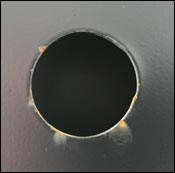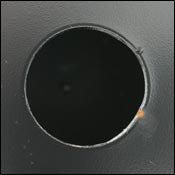Maintaining an Edge
Use of high edge-protective electrocoat expands
Retention of coating along the sharp edges of a substrate is a problem that has plagued many thermosetting paints since their inception. As a wet paint film heats up in the cure oven, the warming discrete polymers go through a “melt” stage of minimum viscosity before enough thermal energy is absorbed to initiate the crosslinking reaction, at which time viscosity increases rapidly. Electrodeposition coatings are no different.
When cationic epoxy electrocoat paint materials were first adopted by the industrial and automotive markets, they provided such a dramatic improvement in corrosion protection that edge protection was an afterthought, if it was noticed at all. But, once cationic epoxy had penetrated deeply enough to have become the industry standard for priming bodies and painting small parts, the spirit of continuous improvement began to shine a light on corrosion of sharp edges.
Since mechanical relocation of edges via part design could only partially solve edge rust issues, a better edge protective electrocoat became necessary. Advanced electrocoat paint formulations that prevent this problem have found widespread application as single-coat finishes for automotive chassis components. Somewhat more slowly, however, the electrocoat marketplace is beginning to realize the benefits of maximum edge protective coatings for a broader range of industrial and automotive components.
What About Tests?
Without a cost-effective standardized test method, formulation improvements would be educated guesses at best. Development of the knife-blade edge coverage test in the late 1980s provided a quick and inexpensive way to quantify electrocoat edge coverage. The test involves exposing the sharp edge of a controlled, electrocoated knife blade to standard ASTM B 117 salt-spray testing for one week, then using a microscope to count the number of discrete rust spots that appear along the edge.
This test allowed creation of automotive body electrocoat paint materials that were deemed “high-edge” if they returned fewer than 40 average rust spots after knife-blade testing. This cutoff was selected because visual film appearance, defined by peak-to-valley surface profile measured in microinches, and edge protection are inversely related. Experiments showed that 40 rust spots provided an ideal balance between improved edge protection and cured film smoothness.
An automotive chassis electrocoat application, unlike its use as primer for a body panel, has no requirement for film smoothness. The frame of a passenger car or light truck is strictly a functional portion of the vehicle, with no consumer expectations for appearance. Because film smoothness was unnecessary, several global auto manufacturers created electrodeposition specifications designed for frame and chassis components and requiring knife blade performance of 0–5 rust spots after salt spray exposure.
Edge Protection: A Technical Perspective
Any thermosetting coating must proceed through a melt phase as it heats up to the temperature at which it can chemically crosslink, or cure. During this phase, the film has an opportunity to flow and level itself, ideally resulting in a very smooth and attractive film which is both aesthetically appealing and able to resist corrosion. In a simplified way of thinking, maximizing edge protection is all about minimizing the amount of flowing the coating can do as it warms through its melt phase and into its crosslinking phase.
By plotting viscosity versus curing time and temperature, viscosity curves can be generated for any paint material. The lowest point on each viscosity curve shows the point of minimum viscosity (maximum flow) just before crosslinking begins. It is at this point during the cure process that the deposited film behaves most like a liquid.
During deposition, an electrocoat product will coat out on any exposed metal surface, including directly on the very sharp edge of a knife. If the minimum melt viscosity is low enough, however, the deposited film will pull back on itself during cure. This occurs due to the surface tension of the coating, resulting in very thin or no coating along that sharp edge. Thin or nonexistent edge coverage after cure translates directly to poor performance in the knife edge test.
Any formula modification that can increase minimum melt viscosity will provide improved edge protection by restricting the amount the coating is able to pull back on itself before crosslinking begins and the film is locked in place. The three most obvious ways to restrict flow during cure are removing excess flow agents such as solvents and plasticizers, increasing pigment loading and modifying the coating polymer itself. Each of these approaches has its positives and negatives.
Reducing the solvent or plasticizer level in a formulation can be a simple thing to do on paper, but this type of adjustment can have a negative effect on manufacturability, bath stability, film build and throwpower.
An increase in pigment loading is often even easier to achieve than a solvent reduction, especially in a two-component feed system. All that’s required is a simple adjustment of feed ratio to increase the amount of pigment paste fed in relation to resin. Because there is nothing fluid about solid pigments, regardless of temperature, increased pigment levels generally equate to restricted flow during cure and therefore better edge protection.
Of course, some pigments are better at this than others. The possible downsides of increased pigment loading include settling, decreased UF performance, changes in gloss and, most importantly, increased applied paint cost.
The third way to modify the minimum melt viscosity of an applied E-coat film is to change the properties of the E-coat resin polymer itself. With adjustments in its chemical synthesis, a polymer can be induced to behave very differently as it melts and flows out before curing. Generally speaking, increases in molecular weight lead to restrictions in flow and therefore better edge coverage.
This approach is by far the most complicated of the three. Polymer makeup and molecular weight are critical to just about every property an electrocoat product delivers, from manufacturability to initial storage and bath stability right up through final cured film physical properties and corrosion resistance.
Measuring Edge Protection
The knife blade test for edge corrosion protection has already been discussed. Although it remains the most quantitative test referred to in current automotive body and parts specifications, it does have a tendency to give a wide standard deviation. An experienced operator can reduce deviation somewhat by pre-screening uncoated blades before coating, but results can vary widely even after culling out blades with obvious nicks, burrs, or uneven pretreatment.
A number of European automotive OEM specifications have requirements for edge protection. But, instead of attempting to define the protection on a controlled and repeatable edge like the knife blade test, these requirements are expressed in terms of the total percentage of any part edge that demonstrates signs of corrosion after standardized testing—for example, in VDA cyclic corrosion. The requirements remain the same from part-to-part, creating the potential situation of a given electrocoat material being able to meet the spec on part A but fail on part B, if the design of part B happens to incorporate more sharp edges than that of part A.
Several electrical methods of edge coverage determination have also been explored. Because the typical cured electrocoat film acts as an insulator, any electrical current able to pass through the paint along a sharp edge should be indicative of thin or no coverage. Current measurements can either be taken along the entire edge simultaneously or as a function of distance traveled along the edge using a spot probe.
In theory, this type of test method should be the most reliable of those mentioned so far, but in many cases it can be difficult to achieve enough correlation of test results to knife edge or field performance results.
To date, an electrical method of edge determination has not been defined and proven enough to have been accepted and written into specifications by any large automotive OEMs.
Finally, various cross-section microscopy techniques exist to allow clear visual or SEM evaluation of the amount of coating present along any sharp edge. As long as the edge in question can be cut into a small enough piece, it can be cast in resin and polished to allow optical determination of edge coverage.
Regardless of accelerated measurement techniques, the ultimate test of any edge protective electrocoat paint is the observable incidence of edge corrosion on parts in field studies from actual service environments. But because of the needs of product development laboratories and material approval groups, shorter-term evaluations of edge protection will remain in use for the foreseeable future. Table 1 shows edge-protection speciciations currently used by several global automotive OEMs.
From a documentation point of view, nothing substantial has changed recently—in many cases, up-to-date OEM specifications for edge protection look much like they did three, five or even eight years ago. However, coaters have begun to appreciate that, with all other things being equal, better edge coverage is always a good thing. As long as negatives like large cost increases, excessive roughness and bath stability problems can be avoided, painting parts with a demonstrable improvement in edge protection should provide a competitive advantage in the marketplace.
| Table 1. Currently Specified Edge Protection | |||||
|
BMW
|
Chrysler
|
Ford
|
|||
| GS 90011 | ≤ K2 after VDA DMS-PB-60-2B,C |
MS-PB-60-2A, | ≤ 5 rust spots no requirement |
WSB-M64-J28 WSB-M64-J36 WSS-M64-J39 WSS-M64-J40 |
no requirement no requirement ≤ 40 rust spots ≤ 5 rust spots |
|
GM
|
Honda
|
Mercedes
|
|||
| 9984120 9986165 GMW14671 |
no requirement 0–5 rust spots ≤ 20% edge rust after salt spray |
HES D2021 5100Z-SEO-0000 5100Z-SGO-0000 |
no requirement no requirement no requirement |
DBL 7391.04/54
DBL 7391.10/60 |
KR 2 Salt Spray KR 2 CASS/Alum. |
|
Nissan
|
Toyota
|
VW
|
|||
|
NES M5050 NES M5083 |
no rust, |
TSH 2354G | no requirement | PV 1210 |
no specific |
Related Content
Sustainability, Electrification and Mobility
Industry events like ECOAT are good indicators of the trends that are top of mind for those in manufacturing.
Read More10 Ecoat Best Practices
Following this list of guidelines can help to increase the performance, cost effectiveness and quality for your ecoat operation.
Read MoreFinishing Systems Provider Celebrates 150 Years, Looks to Future
From humble beginnings as an Indiana-based tin shop, Koch Finishing Systems has evolved into one of the most trusted finishing equipment providers in the industry.
Read MoreInstalling an Ecoat Line
Thinking of investing in electrocoating capabilities? George Lovell, coatings plant manager for Lippert, discusses considerations you should keep in mind as you add your ecoat line.
Read MoreRead Next
Episode 45: An Interview with Chandler Mancuso, MacDermid Envio Solutions
Chandler Mancuso, technical director with MacDermid Envio discusses updating your wastewater treatment system and implementing materials recycling solutions to increase efficiencies, control costs and reduce environmental impact.
Read MoreA ‘Clean’ Agenda Offers Unique Presentations in Chicago
The 2024 Parts Cleaning Conference, co-located with the International Manufacturing Technology Show, includes presentations by several speakers who are new to the conference and topics that have not been covered in past editions of this event.
Read MoreDelivering Increased Benefits to Greenhouse Films
Baystar's Borstar technology is helping customers deliver better, more reliable production methods to greenhouse agriculture.
Read More


















.jpg;maxWidth=300;quality=90)







